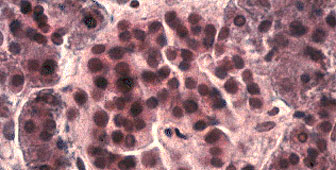Geneva scientists gain new insight into diabetes

Scientists at Geneva University have found a new lead in the cause of diabetes. The discovery means a new treatment could be developed for diabetes type II, which accounts for 95 per cent of patients suffering from the disease.
Scientists have been struggling for decades to identify a cause of diabetes type II, which affects at least five per cent of people in the west.
But now researchers from Professor Paolo Meda’s team at the morphology department of the faculty of medicine think they may have made a breakthrough. The key problem is to find out why cells in the body, which produce insulin, suddenly start malfunctioning, leading to the onset of the disease.
“We know diabetes is mostly due to a defect in the cells producing insulin,” said Meda. “What is strikingly in type II diabetes is that although these cells are present in normal numbers and produce the hormone at about normal levels, they lose their ability to detect increases in glucose levels.”
Scientists have traditionally assumed that something has gone wrong with individual cells. However, Meda’s team decided to take a different approach.
“We started observing that insulin cells always grow and function as groups. They also exchange signals, like many other cells in the body, so we began to suspect that the defect might lie in the communication between insulin cells rather than in the cells themselves.”
Meda’s team discovered that by increasing or decreasing the level of a protein called connexin, which forms the links between insulin cells, they were able to stop cells behaving normally. In fact, any fluctuation in the quantity of the protein resulted in an intolerance to glucose.
The discovery means that scientists can now shift their attention from insulin cells to this particular protein.
Meda says the discovery provides “a more defined target for treatment”. He says there are already drugs, which can regulate the connexin protein, but that they are only suitable for laboratory use at the moment.
“The challenge is to manipulate those drugs so they can be used by human beings.”
The findings will be published in the “Journal of Clinical Investigation” on Saturday.
swissinfo with agencies

In compliance with the JTI standards
More: SWI swissinfo.ch certified by the Journalism Trust Initiative
You can find an overview of ongoing debates with our journalists here . Please join us!
If you want to start a conversation about a topic raised in this article or want to report factual errors, email us at english@swissinfo.ch.